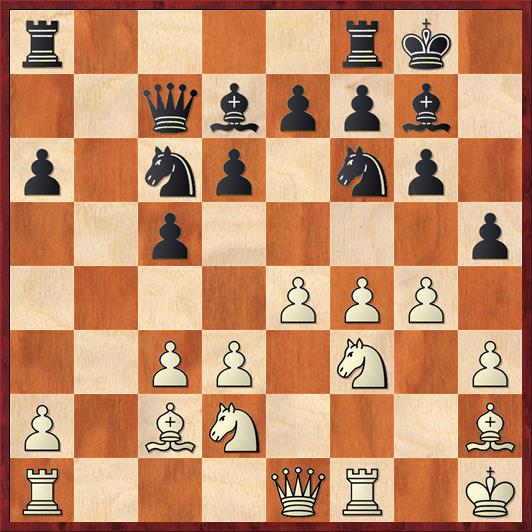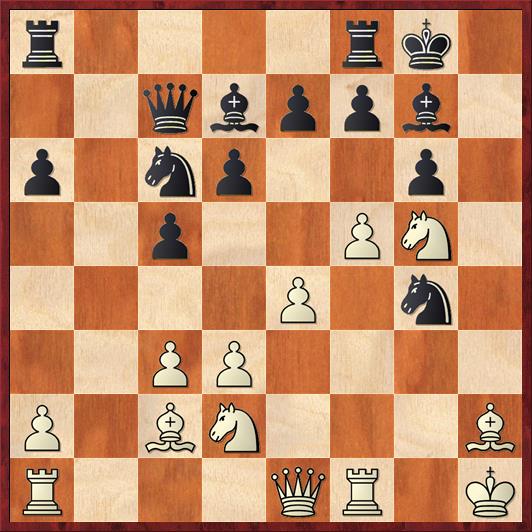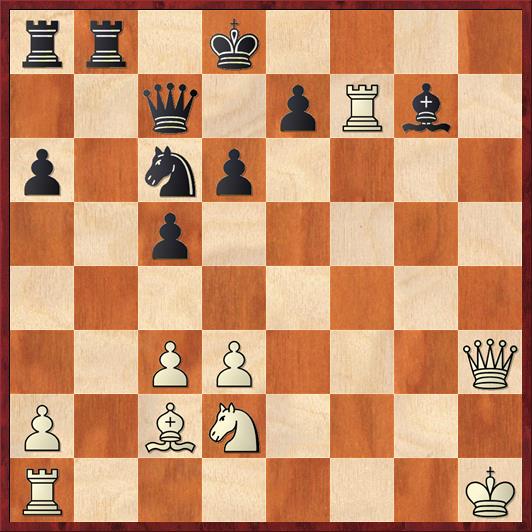To be or not to be? To play e5 or f5? These are the great dilemmas in life.
A few weeks ago I wrote about a game I played with Shredder where I had to make a decision between e5 and f5 at a crucial point (although as Gjon Feinstein pointed out, d4 was also really good). Last week I played another very exciting game against the computer in which the same thing happened. It seems to be a recurring theme in the Grand Prix Sicilian.
 Position after 18. … h5. White to move.
Position after 18. … h5. White to move.
FEN: r4rk1/2qbppb1/p1np1np1/2p4p/4PPP1/2PP1N1P/P1BN3B/R3QR1K w – – 0 19
Shredder is Black here, and its strength was set at 2009. I didn’t take a time-out in this position, but perhaps I should have. Black’s last move, 18. … h5?!, surprised me. The computer had just traded pawns on c3 and I was expecting a move to put more pressure on my queenside. In fact my other computer program, Rybka, agrees with me and says that Black should have played … Rab8 or … Ne8.
The motivation behind 18. … h5?! is clear. It’s trying to provoke 19. g5, when after 19. … Ne8 or 19. … Nh7 the bishops will be attacking two weak pawns (c3 and h3) at once. I can’t defend them both.
So at first glance the position might seem bad for White. I can’t defend the pawn on g4, because it’s attacked three times, and I can’t move it. But to me, that just means I need to fight harder for the initiative. Now, right this moment, is the time for White to counterattack — otherwise, I’ll just get an inferior game.
The two obvious counterattacking moves are 19. f5 and 19. e5. Which one should I play?
Interestingly, the other computer program thinks it’s a no-brainer. (In case you haven’t noticed before, I use weakened Shredder for training because it plays a little more aggressively and sometimes recklessly; I use full-strength Rybka for analysis because it’s not as “emotional.”)
According to Rybka, after a search to a depth of 13 ply, 19. e5 is by far the best move, with an evaluation of +0.38. Rybka’s main line calls for Black to win three pawns for a piece with 19. … hg!? 20. ef Bxf6 21. Ng5 Bxg5 22. fg gh. Although material is nominally equal, I would be much happier with White here. In the middlegame the piece is generally stronger than the three pawns, and in this position White has a lot of targets. All of Black’s pawns on f7, e7, and d6 are under pressure, and Black has to constantly “babysit” the h3 pawn in order not to lose it. To me, a bigger concern is the move 19. … Nd5, when after 20. gh Bxh3 21. Rg1 Bf5 the position looks like a mess. Yes, Black’s kingside is shaky, but so is White’s center.
On the other hand, Rybka evaluates 19. f5 as better for Black (-0.46), even after a 13-ply search. To me, this evaluation is just plain wrong. White sacrifices a pawn, but in the process of taking the pawn, Black does exactly what White wants: he opens up the g- and h-files and weakens the defense of f7 and h7. After 19. f5 hg 20. hg Nxg4 21. Ng5!, which is what happened in the game, White has the immediate threat of 22. Qh4 followed by 23. Qh7 mate. Also, 22. fg is a big threat, after which there is huge pressure on f7 and Black cannot recapture because of Bb3+. To be honest, I couldn’t see a clear defense for Black. Can you?
 Position after 21. Ng5. Black to move.
Position after 21. Ng5. Black to move.
FEN: r4rk1/2qbppb1/p1np3n/2p2pN1/4P2Q/2PP4/P1BN3B/R4R1K w – – 0 23
Of course, if Black goes into all-out greed mode with 21. … Bxc3? he will get mated after 22. Qh4 Nf6 23. fg (threatening Rxf6!) Kg7 (everything else loses immediately) 24. Rxf6! Rh8 25. Rxf7+ Kxg6 26. Rh7 with the threat of Qh6 mate. It’s hard to believe that a move like 21. … Rfb8 could work, because after (say) 22. fg Nf6 23. gf+ Kf8 24. Bb3 White still has serious mating threats on g8.
I decided to let Rybka run for a very long time on the position after 19. f5 hg 20. hg Nxg4 21. Ng5 to see if there was some defense I was missing. It was interesting to see how the evaluation changed as it looked deeper and deeper.
First impression (8 ply): 21. … gf (-0.66). This makes sense; Black stops the threat of 22. fg.
10 ply: 21. … gf (-0.31), 21. … Na5 (+0.19).
11 ply: 21. … gf (-0.17), 21. … Na5 (+0.24).
12 ply: 21. … gf (0.00), 21. … Na5 (+0.24).
13 ply: 21. … Na5 (+0.31), 21. … gf (+0.40). The big switch!
14 ply: 21. … Na5 (+0.29), 21. … gf (+0.67).
The message seems pretty clear. Rybka thought at first that 21. … gf was pretty good for Black (two-thirds of a pawn advantage), but at a depth of 7 move pairs (14 ply) the evaluation has completely switched, and it thinks White has a two-thirds of a pawn advantage. I completely agree. Although it’s hard to find a completely forced win, it just seems as if Black’s dike is springing too many leaks after 22. Qh4 Nh6 23. ef with ideas of N2e4 and f6.
On the other hand, the cool and calm (and some might say, computer-like) move 21. … Na5! starts out as slightly in White’s favor and stays that way — only slightly in White’s favor. This would be a hard move for a human to spot, because a storm is brewing on the kingside and Black makes a move way over on the other side of the board. But actually, it’s a good example of playing on both wings. Black stops the threat of Bb3+ (or at least takes most of the sting out of it) and opens up the long diagonal for his bishop (… Bc6) or queen (… Qb7), taking advantage of White’s awkwardly placed king. Meanwhile, Black’s kingside is hard to break down after 21. … Na5 22. Qh4 Nh6 23. fg fg.
If you’re wondering what actually happened, Shredder (which, remember, was not playing at full strength) played the much worse move 21. … Nxh2? — a move that trades off one of Black’s best defenders for one of White’s least dangerous attackers. This is actually a somewhat human-like mistake; humans rated 2009 are also prone to trading good pieces for bad ones.
The game continued 22. Qh4 Rfb8 23. Qxh2 (I really wanted to continue in Morphy-esque fashion, piling on one sacrifice after another, but sometimes you have to be realistic and take the free piece.) Then it went 23. … gf 24. ef?! (Rybka likes 24. Rg1 better) Kf8 25. Ne6+! fe 26. fe+ Ke8 27. ed+ Kxd7 28. Qh3+ Kd8 29. Rf7 …
 Position after 29. Rf7. Black to move.
Position after 29. Rf7. Black to move.
FEN: rr1k4/2q1pRb1/p1np4/2p5/8/2PP3Q/P1BN4/R6K b – – 0 29
Against a human opponent, especially one rated 2009, I would be expecting a resignation soon. It looks as if Black has no way to hold the bishop without allowing me a fatal back-rank check. But Shredder comes up with a ri-DONK-ulous solution:
29. … Nb4!
There’s no such thing as a routine win against a computer! After a few seconds of disbelief I saw that after 30. cb? Black has an intermezzo: 30. … Qc6+! creating a flight square for his king, and then he can calmly play 31. … Bxa1. I also didn’t like 30. Ba4 because it seemed to give Black time for 30. … Qb7+ 31. Kg1 Bxc3. So I played
30. Bd1,
which prepares to interpose the bishop on f3 and asks Black how he is going to get his two pieces out of attack. Typically, Shredder didn’t move either one, but instead played another crazy move:
30. … d5?! 31. Rxg7 Qe5
Threatening three things at once — Qe1+, Qxg7, Qxc3 — but fortunately I have an easy answer that trumps all of them. I can threaten checkmate!
32. Ba4 Kc7 33. Qd7+ Kb6 34. Rg6+ e6
34. … Ka5 35. Nb3 would be checkmate.
35. Rxe6+ resigns
Well, that was fun! Most of the time, the sacrifices and attacks that would win against a human fall short when you play a computer, because of its inhuman precision. So it’s nice to have a game every now and then where everything works out, even if you have to set the computer on less than full strength. Even if the computer is weakened, you’ve still got to be prepared for crazy tactical ideas like 29. … Nb4.
As for the eternal dilemma, “Should I play e5 or f5?” I think that the conclusion from this game is: “Yes.”


